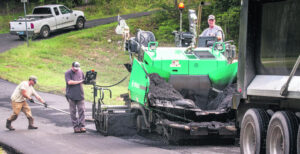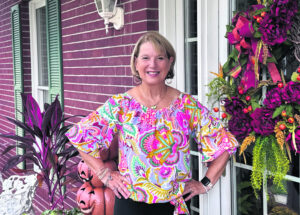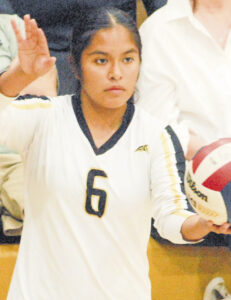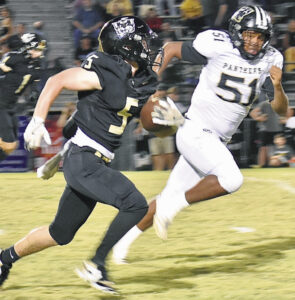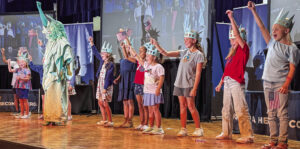Class of ’65 celebrates school’s centennial
CHEROKEE — In August, Cherokee High School commenced classes for its 100th year since the campus first opened as a vocational school in 1925. This month, alumni of the class of 1965 gathered in the cafeteria to reflect on the milestone, reminisce, and share the school spirit they’ve each carried for 60 years since they last walked the halls of Cherokee High.
“I’m extremely proud of where I graduated,” said Tommy Heard.
“That’s what I was going to say,” his former classmate, Jim Carpenter, chimed in. “In those days, if you were from Cherokee, you had respect from other schools in the area.”
Carpenter, like several others in his class, had roots in the school that ran as deeply as its history.
“My mother finished school in 1926, and she was by far the youngest in her class because a lot of them had been out. By the time they came back to school, they were four or five years older than her,” Carpenter said, explaining that in the school’s earliest days, students often had to sacrifice time studying for days in the field, helping their parents on the farm.
By the time Carpenter, Heard, and their fellow classmates were students at Cherokee High, times had changed — but not by much.
“If students had to be on the farm at cotton picking time, the school didn’t stop. We didn’t close the school, but even when I was here in junior high, those kids were excused,” Mitzi Harris Martin said. “You know, those families didn’t eat if the kids weren’t there to help pick that cotton.”
Heard, Carpenter and Dwight Rivers all remember getting out for two weeks each fall to help their own families with the cotton harvest.
“Even though that twoweek period stopped, if you lived on a farm and had to be in the field, you weren’t counted absent,” Rivers added.
Still, by the early 1960s, profound changes were beginning to take place at the school.
In 1959, a new building had been erected that included the cafeteria and new classrooms for students in grades 10 through 12. At that time, students in grades seven through nine continued meeting in the original schoolhouse — the building that once bore the name Cherokee Vocational High School.
Prior to 1966, classes at the school had only been open to white students in the area. The year following Heard’s and his classmates’ graduation, voluntary integration was taking place. The school admitted its first Black students, and by 1968, integration had been fully mandated.
“We were the last class in a non-integrated Cherokee school,” Martin said, somberly.
As the school — along with others around the nation — was making slow strides to correct its longtime racial discriminatory practices, changes were happening to end gender discrimination as well.
Martin and her classmate, Carol Cain Henry, graduated about five years too soon to enjoy some of the privileges their male classmates enjoyed. Following the passage of Title IX, which prohibits sex-based discrimination in federally funded education programs, Cherokee High introduced its first athletic programs for female students in the early 1970s.
“I was in the band, but there were no competitive athletics for women when we were in school,” Henry said. “I remembered doing the Maypole dance in the gym. In the cold months, we had square dancing in P.E., and when it got warm, the girls got to go outside and play softball.”
“Opportunities for women nationwide were pretty slim. Cheerleading was it if you wanted to run and jump,” Martin agreed. “I’ve always said, one of the reasons that men could get places faster than we could, even after entering the professional world, is because athletics were the fertile ground for teaching teamwork, competition, and all those things that lead to success in business. We have a lot of successful businessmen from our graduating class, but my little sister could have outrun any of them.”
Still, Martin and Henry share their male classmates’ sense of school pride for the athletic prowess Cherokee High students exhibited who were allowed to compete on the field and on the court.
“Cherokee had a long lineage of football and basketball success. Most schools our size wouldn’t play us,” Carpenter said, recalling a time before the Alabama High School Athletic Association existed to create competitive divisions based on enrollment. “We’d play big schools like Corinth, Tupelo and Columbus, Mississippi. We had some All-Americans too.”
Cherokee High produced several talented athletes who found fame in their sport beyond high school.
Among those were Bill Alexander, who continued his basketball career at Auburn University, was inducted into the Auburn Basketball Hall of Fame in 1984 and holds the record for most points scored in an Alabama High School State Basketball Tournament — 52 points.
Cecil Dowdy Jr. was an All-American offensive lineman who played on two national championship teams at the University of Alabama in 1964 and 1965 and was later drafted to the Cleveland Browns and the Los Angeles Rams.
“Cecil was two years older than us, but we were good friends,” said Heard, who played football and basketball with his school’s team alongside Carpenter, who also played baseball.
“The last time we played Deshler, we beat them 47 to 13,” Heard said, recalling some of his most memorable football games. “And we’re not only talking about the 1950s and ‘60s. Jim probably remembersthistoo,not because we were around, but from hearing our parents, aunts and uncles talk about it. Back in the 1930s, Cherokee was unstoppable in football. They played and beat Huntsville High School.”
During Heard’s father’s time with the team, the players for Cherokee High often squared up against the only high school team representing Huntsville at that time. By the time Heard and Carpenter joined the team, they competed against Sparkman High, Madison Academy and another large team from Decatur.
Back in the classroom, there were other legendary leaders who left a lasting impression on the students at Cherokee.
“Iwillsayonethingabout the school for our period — and probably before and after us — we had some wonderful teachers when we were there,” Martin said. “They may not have been particularly loved at the time, but the ones who were tough, at least I can say for myself, they affected my career path.”
Martin listed teachers like Elizabeth Foster, Jane Foster Boozer and Herman Hendricks, who helped shape her own career in education. After graduating from Cherokee, Martin enrolled at Auburn University, where she taught for one year after obtaining her degree.
She later moved to Franklin, Indiana, where she taught for six years before pursuing her master’s and later a law degree that led to a practice she kept for about 48 years.
“I think what I saw from the teachers I had in Cherokee really did impact the quality of education we received here,” Martin continued. “We were the ones who really benefited from them.”
“The stricter teachers taught you a lot more. To tell you the truth, some of them I absolutely hated,” Rivers agreed with a laugh. “We didn’t realize it at the time, but later on in life, you realized they taught you so much.”
While each of the five classmates had very different career paths, they all concede that the foundations built for them in Cherokee helped sustain them into adulthood.
“The school was a reflection of the community,” Henry said. “We were taught to work hard, to respect people, to do our best. We were a very closeknit community.”
That legacy, the alumni said, is one they believe continues for students who walk the halls of the school today.
“Cherokee turned out good citizens, good workers and good, honest people,” Heard said. “I think every student who went here has a pride about them. We went to the best school.”


